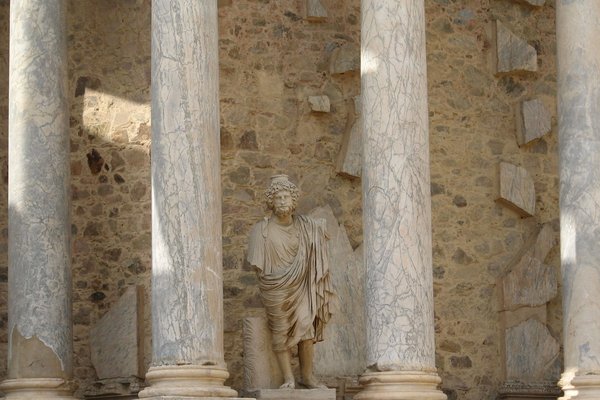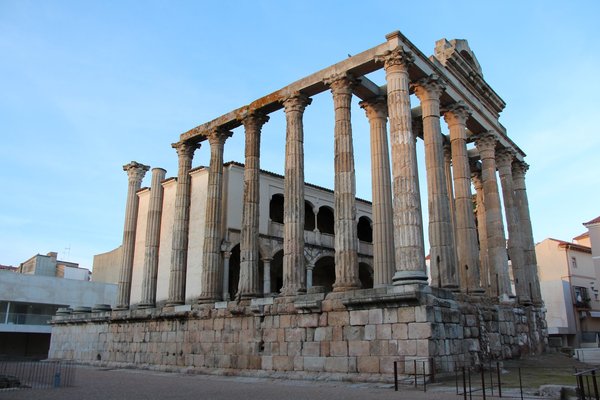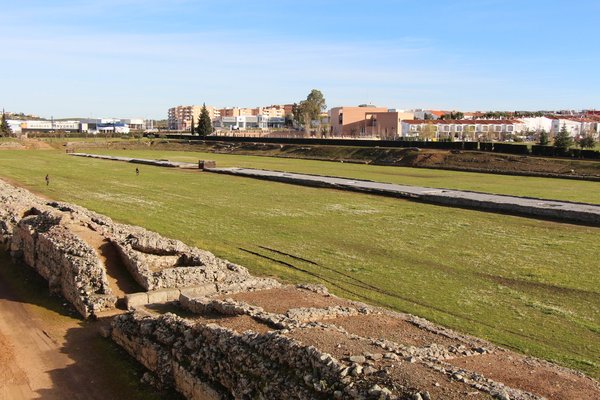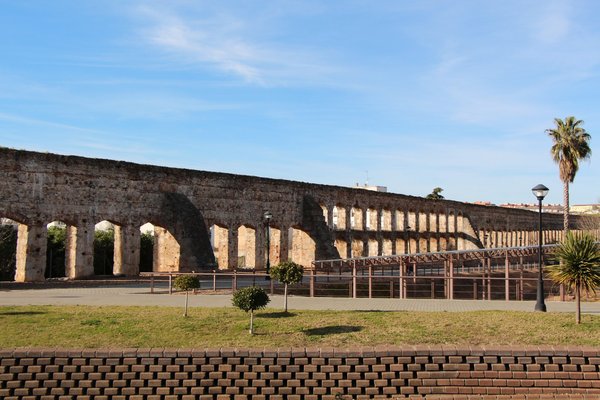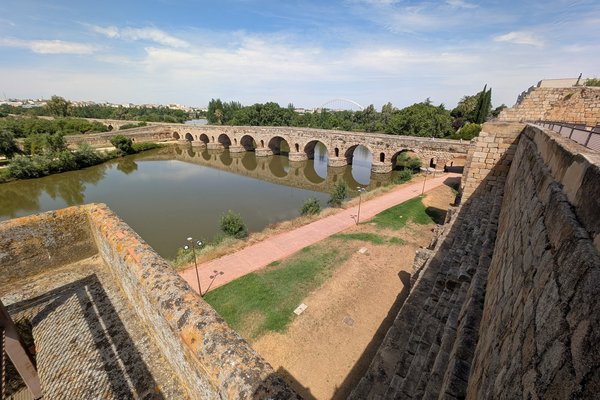Spain
Mérida
The Archaeological Ensemble of Mérida holds the remains of many public buildings that were the trademarks of a major Roman provincial capital.
The city was built as Emerita Augusta in 25 BCE, adhering to a strict Roman urban plan. Mérida preserves both public and private buildings from Antiquity, such as the theatre, amphitheatre and engineering works. The Ensemble also includes a few later monuments like the Moorish Alcazabar and two early Christian churches.
Community Perspective: The quality lies in the ensemble of the various components, as together they show every aspect of life in a Roman city. There’s a combined ticket that gives you access to all. The National Museum of Roman Art is also worth visiting.
Site Info
Official Information
- Full Name
- Archaeological Ensemble of Mérida (ID: 664)
- Country
- Spain
- Status
-
Inscribed 1993
Site history
History of Mérida
- 1993: Inscribed
- Inscribed
- Type
- Cultural
- Criteria
- iii
- iv
Links
- UNESCO
- whc.unesco.org
- Official
-
- merida.es — Merida city
- Related
-
- livius.org — Augusta Emerita - by Livius, Articles on Ancient History
- museoarteromano.mcu.es — Museo de Arte Romano
All Links
UNESCO.org
- whc.unesco.org — whc.unesco.org/
Official Website
- merida.es — Merida city
Related Resources
- livius.org — Augusta Emerita - by Livius, Articles on Ancient History
- museoarteromano.mcu.es — Museo de Arte Romano
News Article
- March 18, 2015 euroweeklynews.com — Padel tournament at Amphitheatre of Merida draws protests
Community Information
- Community Category
- Archaeological site: Ancient Rome
Travel Information
Recent Connections
-
Perfect Inscriptions
1993 -
Locations for playing sport
Roman circus -
Notable Dams
The Proserpina and Cornalvo dams, both …
Connections of Mérida
- Individual People
-
-
Emperor Trajan
Trajan's Arch
-
- Trivia
-
-
Depicted in Mizielinska Maps
Roman amphitheatreSee i.pinimg.com
-
- History
-
-
Ancient Roman colonies
Emerita Augusta -
Almohads
Mérida was under Almohad control until its citadel fell in 1230, when it was conquered by Alfonso IX of León. (wiki)See en.wikipedia.org
-
- Architecture
-
-
Mosaic art
Mytraeum House, Amphiteatre House
-
- World Heritage Process
-
-
Perfect Inscriptions
1993
-
- Religion and Belief
-
-
Early Christianity
"The Basilica de Casa Herrera basilica with a double-apsidal well known North African type" (AB eval). The Basilica of Sta Eulalia was built over the remains of a former paleo-christian basilica and necropolis and is thought to contain the tomb of the child Saint Eulalia burned in 304 for spitting in the face of a Roman magistrate. This crypt has been extensively excavated since 1990 and can be visited underneath the basilica
-
- Human Activity
-
-
Locations for playing sport
Roman circus -
Irrigation and drainage
The Proserpina and Cornalvo dams, both still functioning, are the most remarkable surviving examples of Roman water management systems. (AB)
-
- Constructions
-
-
Notable Dams
The Proserpina and Cornalvo dams, both still functioning, are the most remarkable surviving examples of Roman water management systems. (AB) -
Triumphal Arches
Trajan's Arch -
Theatres and Opera Houses
Roman theatre -
Aqueduct
-
Baths
Termas Romanas de Alange -
Protective Shelters
Covering the Roman mosaics -
Hospitals
Xenodochium -
Notable Bridges
Puente Romano, the longest surviving bridge from ancient times, having once featured an estimated overall length of 755 m with 62 spansSee en.wikipedia.org
-
Roman amphitheatres
Roman amphitheatre -
Obelisk
Glorieta de las Méridas del mundo
-
- Timeline
-
-
Built in the 1st century BC
Emerita was founded by Augustus in 25 BC, Guadiana bridge 25 BC, amphitheatre 8 BC
-
- WHS Hotspots
News
- euroweeklynews.com 03/18/2015
- Padel tournament at Amphitheatre o…
Recent Visitors
Visitors of Mérida
- Adam Hancock
- Adolfo
- Adrian Turtschi
- Alberto Rodriguez Gutierrez
- aleserre
- Alexander Barabanov
- Alexander Lehmann
- Alikander99
- Ali Zingstra
- Ammon Watkins
- Ana
- Ana Lozano
- Anna Wludarska
- Antonio J.
- Argo
- Artur Anuszewski
- AS
- Atila Ege
- Bill Maurmann
- Bin
- Bruno_Pires
- CampbellME
- Caspar
- Catoplayer
- chenboada
- Cheryl
- Chinmaya
- Christian Wagner
- Christoph
- Christravelblog
- Claire Bradshaw
- Clyde
- Corinne Vail
- Csaba Nováczky
- CugelVance
- Daniela Hohmann
- Dan Pettigrew
- David Berlanda
- debatecoach
- Dennis Nicklaus
- Dimitar Krastev
- Dimitrios Polychronopoulos
- Dolemite92
- Don Irwin
- DonQuijote
- Dorejd
- Elf21
- Elis
- Els Slots
- Emilia
- Emili Xaus
- Errol Neo
- Eva Kisgyorgy
- Evgenii
- Fan Yibo
- Farinelli
- Feldhase
- Felicité
- Femke Roos
- Filip Murlak
- Frederik Dawson
- Gary Arndt
- George Gdanski
- GeorgeIng61
- Gernot
- Hadrianus
- HaraldOest
- Harald T.
- Harry Mitsidis
- henrik_hannfors
- Hubert
- Iain Jackson
- Ivan Rucek
- Jacob Otten
- Jakob F.
- Janina Lehmann
- Janos
- Jarek Pokrzywnicki
- Jasam
- Javier Coro
- Jean Lecaillon
- Jeanne OGrady
- Jens
- Jezza
- JobStopar
- Joel on the Road
- Jonas Hagung
- Jonas Kremer
- Jonas Martinsson
- KarenBMoore
- Ken DJ
- KentishTownRocks
- Kerékgyártó
- Klaus Freisinger
- KngAlaric
- krtek
- Kurt Lauer
- Lara Adler
- lichia
- lindaann
- Lisu Marian
- Little Lauren Travels
- ljowers
- Loic Pedras
- Luboang
- Luis Filipe Gaspar
- Maciej Gil
- Martin
- Martina Rúčková
- maryhattie
- MaYumin
- MH
- M. Huineman
- Michael Novins
- Miguel Marquez
- Mikan22
- Mikko
- Mikko Syrjä
- MMM
- Naim Y
- nan
- napalm
- Nihal Ege
- PabloNorte
- Palimpsesto
- Patrik
- Paul Schofield
- Persian Globetrotter
- Philipp Leu
- Philipp Peterer
- phillipmeng
- Pink Bunny
- Piotr Wasil
- Porcho
- puessergio
- Randi Thomsen
- Reza
- Rick Ohm
- RobRos
- Roger Ourset
- Roman Bruehwiler
- Samy G
- Schnitzel
- Sclowitz
- scubarrie
- Sergio Arjona
- Shandos Cleaver
- Shijie ZHU
- sibariam
- Solivagant
- Stan
- Stanislaw Warwas
- Svein Elias
- Szucs Tamas
- Tamara Ratz
- Taotao Chen
- Tarquinio_Superbo
- Tcchang0825
- Tevity
- Thomas Buechler
- Thomas van der Walt
- Tim Allen
- tony0001
- triath
- Truls Brekke
- ValiaVeweth
- Vanessa Buechler
- Viaje al Patrimonio
- voyager
- Walter
- Wieland
- Wojciech Fedoruk
- Xander Huang
- Xiong Wei
- Xiquinho Silva
- Zoë Sheng
Community Reviews
Show full reviews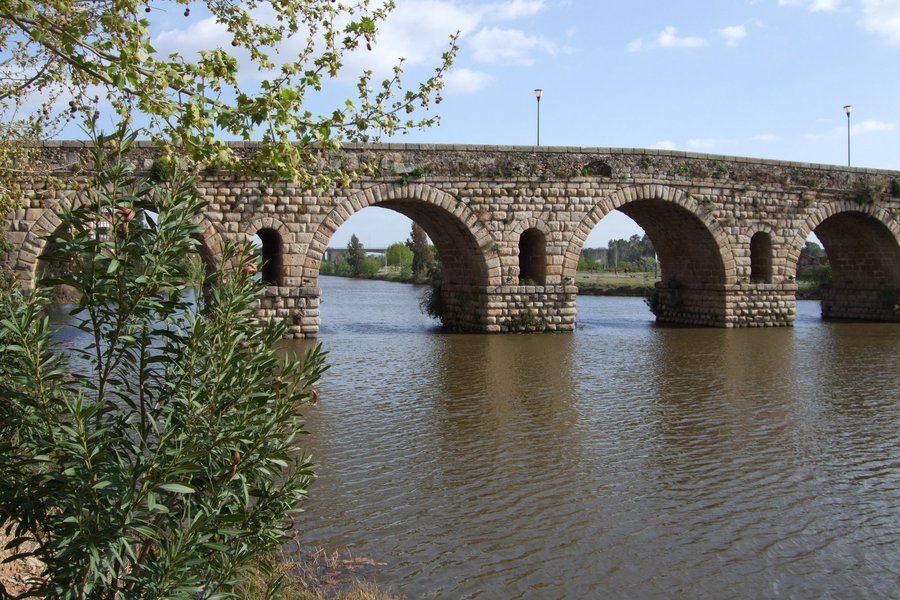
Merida has some cool Roman remnants, but they are all trapped behind fences, which I guess is understandable. But, if you arrive on a day in which they are closed, the fences are also ivied, so you can't see much.
Also, the old town is getting a facelift, which doesn't really make it seem like an old town at all. Perhaps they are readying for hordes of modern shoppers. Maybe I missed the allure, as this was simply a stopover town on our travels.
Had I been there on a day when things were open, I might have felt like I was walking around Rome. But, I also might not have.
Keep reading 0 comments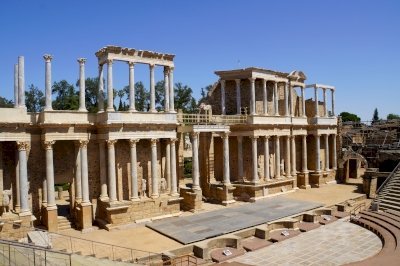
Under the Roman name Emerita Augusta, Mérida was an important centre on the Via de la Plata (Silver Road), the connection between Seville in Andalusia and Astorga in the north. The ancient city had about 50,000 inhabitants, quite large for the time. Today, Mérida is only slightly larger than it was in Roman times, a cosy and leisurely town compared to other sites in Spain.I visited Mérida in May 2019 on a trip through central Spain, it was the southernmost of eleven WHS on this tour. The WHS consists of 22 locations, most of which are within walking distance of the city centre, only a few are located in the countryside outside of Mérida. The combined ticket mentioned in Els' review now costs 15 euros, still a reasonable price for five sites. The opening hours are also pleasing: from 9 am to 9 pm without siesta break, quite unusual in Spain.
The Roman Theatre (photo) is certainly the most visited monument in Mérida. It is well preserved, though the capitals of some columns and parts of the upper frieze are missing and the back wall is not complete. But you can still imagine how magnificent the structure might have looked in ancient times. Right next to it is the Amphitheatre, built for gladiator fights and struggles between wild animals. In Roman times it was probably more popular than its neighbour, at least it offered more seats for spectators. However, only the lower tiers have survived, the stones …
Keep reading 0 comments
Mérida was, in Roman times, the capital of the large province of Lusitania, which stretched across parts of southern Spain and most of Portugal. It was one of the most important Roman cities on the Iberian peninsula and today is one of 2 Roman-themed WH sites in Spain. The other is Tarragona on the Catalonian coast, also a former provincial capital. Mérida does have a star attraction - the very well-preserved Roman Theatre and Amphitheatre -, something that Tarragona doesn't really provide, but Tarragona probably has a higher number of different Roman sites and buildings than Mérida has, so if you are interested in ancient history, it may be worth checking out both places. There are a handful of reasonably impressive Roman-era buildings sprinkled throughout Mérida, such as the Arch of Trajan, the Temple of Diana, and the Roman Bridge (which can still be used today, similar to the one in Salamanca), and there are some nicely preserved remnants of aqueducts which housed many storks' nests when I visited in October. And right next to the Amphitheatre, there is an excellent Roman Museum with a fantastic collection of mosaics. So even if Mérida is certainly a bit off the beaten track, it is definitely worth a visit for anyone with an interest in Roman history.
Keep reading 0 comments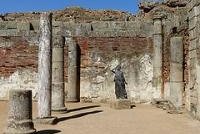
I visited this WHS in August 2014. Merida was my first stopover point after a long road trip in Portugal. It was very hot and dry so the free entrance (being a national holiday) to the National Museum of Roman Art was a godsend. It houses several Roman remains and above all beautiful mosaic floors. Next I visited the Temple of Diana, the Arch of Trajan, the crypt beneath the floor of the church of Santa Eulailia, the thermal baths and a couple of Roman residences and tombs. The combined ticket now costs 12 euros but it's quite worth it for what you get to see. The main highlights are the Roman Amphitheatre and Theatre but before leaving town I also visited the Roman Circus, the Guadiana bridge and the aqueduct. On the whole I must say that I prefer Tarragona due to the amphitheatre's proximity to the Mediterranean Sea and the superb aqueduct there. Merida's star attraction to me was the National Museum of Roman Art.
Keep reading 0 comments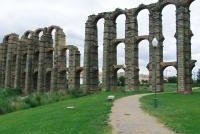
There were a lot of sites to visit within a small area in Merida. The outstanding features for me were the pristine mosaic floors of ancient houses near the amphitheatre and the necropolis in the crypt beneath the floor of the church of Santa Eulailia, which contained more mosaics.
Besides containing interesting exhibits, the Museo Iberico also provided a selection of tasty meals in its restaurant at lunchtime.
Keep reading 0 comments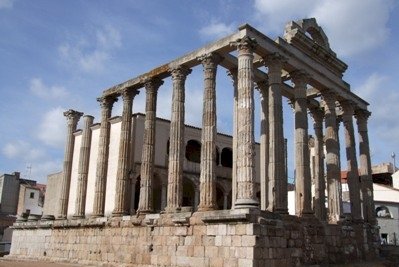
Already at Mérida's admission in 1993, there were 20 other (Mediterranean) Roman heritages inscribed on the List. And many more followed, currently, I count 28 of them and even last year one was added (Serbia's Gamzigrad-Romuliana). "Ancient Rome" is one of the most common site categories. One just wonders how many is enough? My personal favourites so far have been Rome, Pompeii and the Villa Romana del Casale. Before my trip to Extremadura, I wondered what Mérida has to offer that all the others don't.
Modern Mérida feels a bit dilapidated at first sight: graffiti, poor housing. I started my tour of the Roman monuments at the amphitheater and the theatre. For 10 Euros you get an entry ticket to these and the other important sites in town, which can be used over several days. Good value I think. The prize piece is the ancient Roman theatre, which could seat 6000 people and still has a formidable stage with marble columns and statues (although these are replicas).
Close to the theatres is the Roman Museum, which is very much worth visiting. This is where my initial concern faded away. The accomplishments of the Ancient Romans continue to amaze. Remember that the Civilization of Ancient Rome existed really early in history - more than 1000 years before Angkor Wat or Machu Picchu were constructed - and that so much is left, both physical and in writing. There's a well-presented exhibition here about the local Roman road system, the Via …
Keep reading 0 comments
